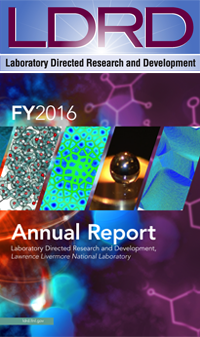Overview
A broad description of the LDRD Program, highlights of accomplishments and awards for the year, program statistics, and the LDRD portfolio-management process.
Advanced Materials and Manufacturing
Meeting national needs for the rapid, cost-effective development of advanced materials and manufacturing processes and systems including innovative new materials and synthesis and characterization methods.
Bioscience and Bioengineering
Working at the interface of biology, engineering, and the physical sciences to address national challenges in biosecurity, chemical security, bioenergy, and human health.
Chemical and Biological Security
Developing innovative systems and capabilities to rapidly detect and effectively respond to intentional use of chemical agents, pathogens, or natural outbreaks of pandemic diseases.
Cyber Security, Space, and Intelligence
Providing national security in a highly networked world through situational awareness and predictive analysis of the behavior of complex systems through investments in developing sensors, information systems, and analytics.
Earth and Atmospheric Science
Supporting climate change analyses, response to atmospheric release emergencies, and wind energy deployment with improved atmospheric and climate models.
Energy and Climate Security
Delivering transformational solutions for national energy security, a re-invented energy grid, improved understanding of climate, and better adaptation to climate change.
High-Energy-Density Science
Providing international leadership in studying the properties of matter under extreme conditions of temperature and pressure including plasma physics, equations of state, and radiation transport.
High-Performance Computing, Simulation, and Data Science
Providing expertise and capabilities in the technically challenging drive toward exascale-class computing at a quadrillion calculations per second for mission-directed programs.
Inertial Fusion Science and Technology
Advancing fusion-related science and technology to meet a broad suite of national security needs and exploring the underlying science, technology, and engineering challenges for sustainable, intrinsically safe, carbon-free energy.
Lasers and Optical Science and Technology
Designing, building, and reliably operating complex laser systems that dramatically advance the state of the art to meet important needs for defense, energy, and industry.
Nuclear, Chemical, and Isotopic Science and Technology
Providing a unique resource for chemical and isotopic analysis of samples in support of wide-ranging research in chemical threat analysis, nuclear forensics, nuclear threat reduction, stockpile stewardship, and fundamental science.
Stockpile Stewardship Science
Providing high confidence in the safety, security, reliability, and effectiveness of the U.S. nuclear weapons stockpile that forms the foundation of annual assessments of stockpiled weapons and their certification.
About the Cover
The cover features a collage of images from a selection of projects presented in the report overlaid on a background artist’s illustration titled “Atom Particle,” by Ezuma Images. The project images from left to right are as follows: (1) The evolution of a wave on a spherical shell simulated using an electromagnetic pulse computing code, featured in project #15-ERD-066. (2) A time-resolved image sequence of a copper–nickel alloy thin film acquired with the dynamic transmission electron microscope, featured in project #15-ERD-006. (3) A simulation of three-dimensional Cu-Ni microstructure, featured in project #15-ERD-006. (4) A three-dimensionally printed electrode exemplar fabricated using large area projection microstereolithography, featured in project #16-ERD-051. (5) 1,179,648 atoms (393,216 water molecules) simulated on the full Sequoia machine, featured in project #15-ERD-032. (6) A two-dimensional phase-field simulation of a Cu-Ni melt pool, featured in project #15-ERD-006. (7) A 15-nm film of formvar polymer stretched across a 5-mm hoop supports a steel ball that weighs 30 mg, more than 80,000× the mass of the polymer film, featured in project #14-ERD-025. (8) An image of a grain consisting of about 2-billion lattice sites from a grain-growth simulation generated using massively parallel kinetic Monte-Carlo code, featured in project #14-ERD-094.






